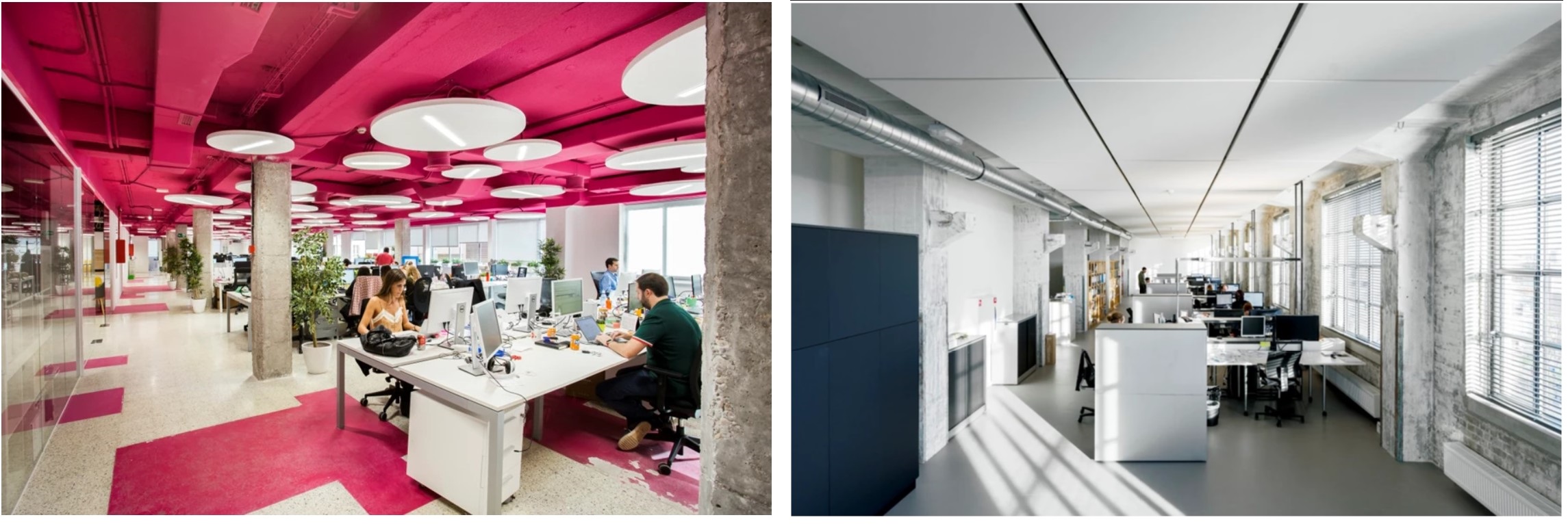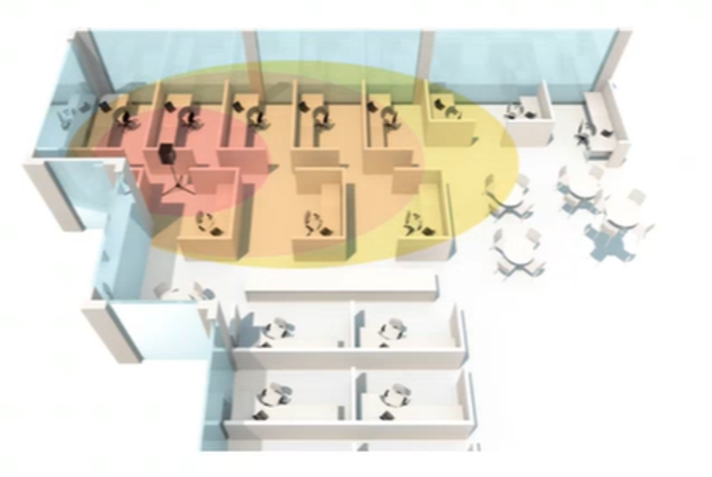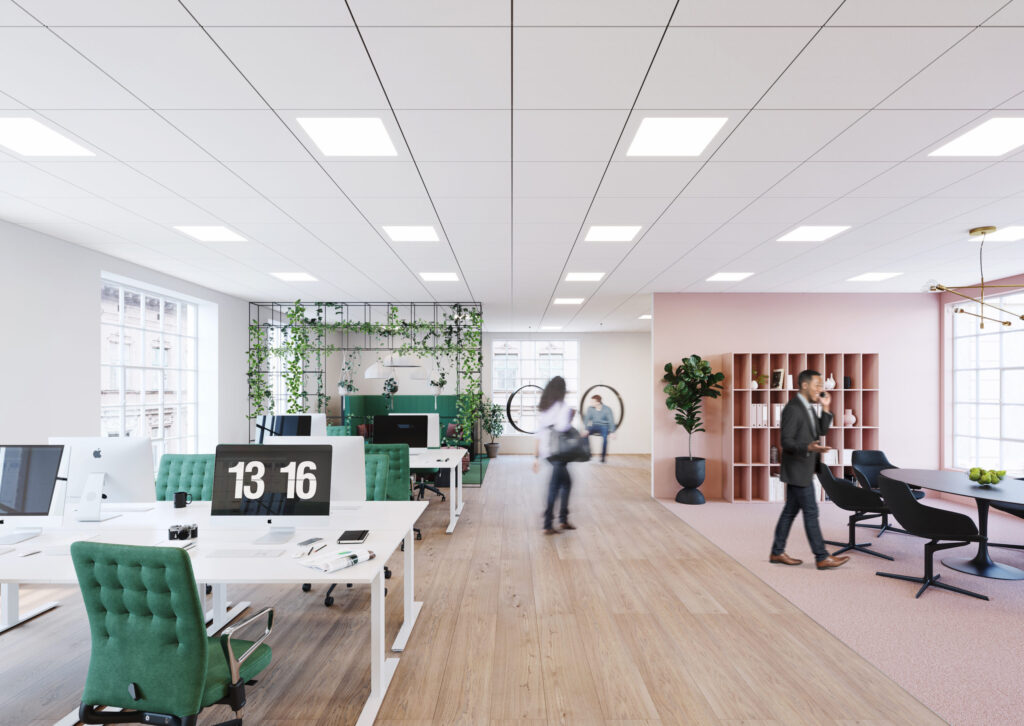
Is the open office a thing of the past? How can verbal communication be the main reason for its existence and simultaneously its biggest acoustic problem? We give you the answers and the solutions in this series on acoustic design of open offices. In this three-part Design Dive series, we, as always, bring you both the context, acoustic theory and practical tips to design good acoustics for a given room type. In terms of office buildings, we have already covered rooms for videoconferencing here.
Open offices after the pandemic?
Ever since the beginning of the COVID epidemic some commentators have been quick to proclaim the death of the office – and in particular the open office. However, when you delve into the actual data there is no solid foundation for this claim. In fact office workers in general do not wish to work from home all of the time.[1] From a strictly financial perspective, this should be enough of a reason for organisations to keep offices running. After all, engaged and inspired employees leave their less-motivated counterparts in the dust when it comes to productivity.[2]
When we look at “hard” measures of productivity during lockdowns the data is not very consistent. Unsurprisingly, specific professions seem to be particularly suited to this type of work while others vary from unsuited to simply tipping towards dysfunction under the new conditions[3].
As Nigel Oseland of Workplace Unlimited aptly points out, any initial jump in productivity might very well be temporary as employees may become under-stimulated and disengaged over time[4].
Socialising, sparring, mentorship and idea generation indeed seem to be the main reasons most employees prefers a home/office hybrid model. The latter is also a concern for organisations, because idea generation is the precursor to innovation. And according to Matt Ridley, author of the book How Innovation Works[5], idea generation is contingent on “serendipitous encounters” between people. Besides our short-term notions of productivity and business, the alarming rise in suicidality[6], general mental illness[7] and drug overdoses[8] in some countries should also make us question whether a more socially isolated work life is really to the benefit of organisations and society as a whole.

When trying to make predictions of the future, organisations like Cushman and Wakefield[9] and the World Economic Forum[10] both project an economic downturn that will result in a temporary reduction in demand for office space. But this is not even close to the “death of the office”, and there is expected to be a rapid bounce-back.
So in short, many aspects of how we work can change in the wake of the pandemic, but the need for office space and hence good acoustics is not one of them. You can find a post on the acoustic design implications of the virus-proof office here.
The ever ongoing debate about open offices
Ever since their conception in the sixties, open offices have been the subject of a great deal of debate. A debate that to some extent is still going on. It still revolves around the same questions of efficacy and productivity, and it is so recursive that renowned experts in workplace design, such as the Danish workplace anthropologist Eva Bjerrum of the Alexandra Institute in Copenhagen[11], do not think there has been any real change in the debate for the past 20 years.
Most professionals in the realm of workplace design will have read at least one case study documenting either the success[12] or the failure[13] of the open office. And most likely several opinion pieces championing one side or the other.
It sometimes seems that the evidence shows that open offices are both the ideal office design solution and a complete scourge on modern life at the same time. The reason is of course that the term “open office” is an extremely broad concept. Whether it supports or hinders work naturally depends on how it is designed, implemented and used. Once again consulting the ever-insightful workplace strategist Nigel Oseland of Workplace Unlimited – this discrepancy can to a large extent be attributed to the fact that some studies on this subject also use somewhat simplistic research methodologies to investigate a very complex issue[14].

In evaluating the overall satisfaction of office workers one fact is abundantly clear: Noise is a problem. The Leesman Index, the world’s largest and most comprehensive workplace satisfaction survey, consistently reports noise and lack of quiet spaces as the biggest complaint of office workers today, right after temperature control.[15] It is well documented that noise is detrimental to any workplace, with effects ranging all the way from the individual level, such as increased stress hormones[16], through the organisational level, such as lost productivity[17] to the societal level, such as increased sick leave[18] and decreased sleep quality.[19]
Read more about how noise impacts workplaces in our research summary here.
It has similarly been proved many times over that attention to acoustic design can mitigate these problems[20]. So if we know both the cause and the solution, why does this problem persist? A myriad of reasons may be cited for this, such as a lack of knowledge of acoustics among the general public, or weak or non-existing regulatory requirements, but from a more holistic perspective these might all stem from a systemic general tendency to over-prioritise the visual aspects of design. Explore this topic further in our three part series on the visual focus in western society.
Room acoustic design for open offices.
Before getting into concrete solutions, it is important to first review the characteristics of the sound environment in question and what technical parameters we should keep in mind when evaluating our designs.
Reasons for implementing an open office configuration often include: ease of collaboration, knowledge sharing, sparring and idea generation. In other words, the exchange of information through verbal communication. Paradoxically, this basic reason for the open-office is also its biggest acoustic problem – irrelevant speech[21].
The overall efficiency and effectiveness of both technical and linguistic cognitive tasks are in most instances degraded by the presence of irrelevant speech. This paradox might seem irreconcilable to laymen, but for acousticians and sound enthusiasts it is actually a rather simple issue to grasp. The distance that sound travels through an office should simply be reduced as much as possible. This enables employees to communicate over short distances without disturbing their colleagues.
The acoustic parameters of distance dampening can be evaluated using several parameters, but are most relevantly described in ISO 3382-3: Measurement of room acoustic parameters – Part 3: Open Offices”[22]
- The spatial decay rate of speech is denoted D2,S and specifies the spatial decay of the A-weighted sound pressure level when the distance from the source is doubled. A D2,S of 3 dB thus represents a reduction of three decibels every time the distance to the source is doubled and would mean a perceived halving of the sound pressure of speech at 16 metres distance. Conversely with a D2,S of 6 dB would mean a halving of the sound pressure at just at 4 meters distance.
- The comfort distance is denoted rc and specifies the distance from the source at which the A-weighted sound pressure level of speech has decreased below 45 dB. In many offices this will effectively mean that the sound of a conversation will fall below or close to the background noise level and effectively be incomprehensible.
- The distraction distance is denoted rd and specifies the distance from the source at which the STI falls below 0.50. In other words, about half of the verbal communication will be incomprehensible at this distance, which means that the acoustic conditions improve as rd decreases.
As open offices are most often multipurpose rooms extending over a larger area, reverberation time is not that effective a measure for acoustic comfort in this domain. In practice, this parameter may vary quite substantially through the entire space.
Therefore, average reverberation time values would not describe the acoustic quality of the entire open office to any satisfactory degree. Consider for example the difference in reverberation times between a lobby, a dining area and a concentration area – all of which could be included in the same open office. Providing an absorption area that is equivalent to a given factor of the rooms floor area (see example in table below) is often used as a rule of thumb for acoustic quality for these types of spaces, and can be useful for assessing acoustic conditions. It should however always be stressed that the acoustic absorption should be distributed more or less evenly over the entire space for this rule of thumb is to be meaningful.
* As proposed in ISO 3382-3
** As proposed in several national guidelines
^ In the frequency range 125-4000 Hz with a permitted deviation of 20 % at 125 Hz.
Acoustic materials
As reduction of sound propagation is the priority for acoustic design in this domain, it is important to utilise highly sound absorbing materials[23] as they will naturally be more effective at improving sound propagation. This is due to the fact that more incident sound is absorbed, decreasing the sound energy of reflections and thereby decreasing sound propagation. Therefore, class-A absorbers are your best choice in open offices.

In open offices it is however more complicated than that. Simply put, the fact that acoustic materials absorb sound differently depending on the angle of the incident sound have an especially significant effect on this sort of space [24]. A lower angle of incidence will mean a lower degree of absorption is provided by most acoustic materials. This issue is especially problematic in open offices due to the fact that this space type is generally characterized by having a relatively low ceiling height relative to floor area. In this type of extended space, distances dictate that there will be a larger area where sound will interact with the acoustic materials installed in the ceiling at lower angles of incidence.

For this reason, it is essential to check the articulation class[25] (AC) when evaluating acoustic materials for open offices. Roughly speaking, articulation class specifies the quality of interzone attenuation by a given acoustic material as it represents absorption quality over an array of angles. In other words, it is the degree to which acoustic material contributes to speech privacy in larger spaces. For open offices, an articulation class of 180 is a must – but the higher the better. Horizontal, free-hanging acoustic units, sometimes also referred to as “acoustic clouds” can be suspended directly above workstations, either below or without a wall-to-wall acoustic ceiling, to raise the articulation class between workstations considerably.
As usual, the ceiling is the most effective surface on which to install acoustic materials, but in certain room shapes and configurations, wall absorbers can also be effective at lessening sound propagation. This is especially true in long narrow “cigar-shaped” rooms with or in cases with less available ceiling space for absorption.
Last but certainly not least, acoustic screens are a highly effective method of lowering sound propagation[26]. Unsurprisingly, placing sound absorbing materials along the path in which sound is propagating is the most effective way to decrease sound propagation and improve speech privacy in an open office. Acoustic screens, either free-standing or mounted on desks should be both highly absorbing and preferably have a hard inner core made from materials such as vinyl, glass fibre or similar to optimise their ability to block sound.
5 most important acoustic design principles for open offices:
- Install acoustic materials in ceiling.
- Use only highly absorbing acoustic materials (class-A).
- Use acoustic materials with an articulation class of < 180.
- Place free standing acoustic screens in the longest paths of sound propagation.
- Install acoustic wall panels strategically to lessen sound propagation and noise pollution.
[X] Addendum – Carpets
We hope you enjoyed this part 1 of our Design Dive into open offices, in which we primarily focused on context along with acoustic parameters and measures. In part 2 we will look at how to prioritize acoustic design interventions and room geometry:
Author: Morten Roar Berg, Global Concept Developer for office environments
[X] Addendum – Carpets are often mistakenly believed to have a significant impact on the overall sound environment. As a general rule of thumb, carpets are either unhygienic or only provide low levels of absorption in the high frequencies. According to page 16, section 6.4.4 of ISO 22955, the main benefit of soft flooring is to reduce sound generation from internal traffic throughout the office.
Sources:
[1] SMARTWAY (2021) ”Returning to Work Survey: How do professionals really feel.” Office employee survey report.
https://smartway2.com/wp-content/uploads/2020/10/Return-to-Work-report-highres.pdf
PwC (2021): ”Its time to reimagine where and how work will get done: PwC’s Us Remote Work Survey” Office employee survey summary.
https://www.pwc.com/us/en/library/covid-19/us-remote-work-survey.html
[2] Harvard Business Review:
https://hbr.org/2015/12/engaging-your-employees-is-good-but-dont-stop-there
[3] Institute for Social & Economic research – University of Essex
https://www.iser.essex.ac.uk/research/publications/working-papers/iser/2020-12.pdf
[4] Workplace Unlimited:
http://workplaceunlimited.blogspot.com/2020/05/working-from-home-psychological-and.html
[5] Matt Ridley: ”How Innovation Works: And Why It Flourishes in Freedom.” Haper Collins Publishers, New York 2020.
[6] Gunnell D, Appleby L, Arensman E, et al.: ”Suicide risk and prevention during the COVID-19 pandemic.” ”COVID-19 Suicide Prevention Research Collaboration,Lancet Psychiatry
https://pubmed.ncbi.nlm.nih.gov/32330430/
[7] Pierce M, Ford T, et al: ”Mental health before and during the COVID-19 pandemic: a longitudinal probability sample survey of the UK population.” Lancet Psychiatry 2020
[8] EHS Today:
https://www.ehstoday.com/covid19/article/21139889/drug-abuse-on-the-rise-because-of-the-coronavirus
[9] Forbes:
[10] https://www.weforum.org/reports/the-future-of-jobs-report-2020
[11] Ecophon
https://www.ecophon.com/cm/articles/knowledge/a-fly-on-the-wall-gives-some-insights-into-office-design/
[12] https://theconversation.com/open-plan-offices-are-not-inherently-bad-youre-probably-just-using-them-wrong-113689
[13] https://www.researchgate.net/publication/326130488_The_impact_of_the_’open’_workspace_on_human_collaboration
[14] http://workplaceunlimited.blogspot.com/2018/08/open-plan-v-private-offices-deja-vu.html
[15] https://www.leesmanindex.com/
[16] Stress and Open-Office Noise, Journal of Applied Psychology, Evans, Johnson, Cornell university, 2000.
[17] David M. Sykes, ”Productivity: How Acoustics Affect Workers Performance in Offices & Open Areas.” Palgrave Dictionary of Economics, 2004.
[18] Fried, Yitzhak: “The joint effects of noise, job complexity and gender on employee sickness absence,” Fried et al from Journal of Occupational and Organizational Psychology, 2002.
[19] Science Direct:
https://www.sciencedirect.com/science/article/pii/S0272494415300293
[20] ISO 3382-3: https://www.iso.org/standard/46520.html
[21] ibid
[22] ibid
[23] Bertelsen, Emilie C. ” The Effect of Airflow Rate and Inlet Temperature on Perceived Thermal Comfort in a Real Office Environment with Diffuse Ceiling Ventilation.” Master Thesis, Aarhus University, School of Engineering, 2017.
[24] ASTM E-1110. https://www.astm.org/Standards/E1110.htm
[25] Van Hout N., & Wenmaekers, R.: ” How ISO 3382-3 acoustic parameter values are affected by furniture, barriers and sound absorption in a typical open plan office.” Procedings of the 23rd International Congress on Acoustics, Aachen, 2019.
http://pub.dega-akustik.de/ICA2019/data/articles/000661.pdf
[26] https://www.sciencedirect.com/science/article/abs/pii/S0003682X19313325







